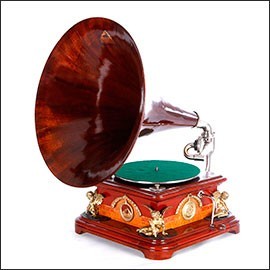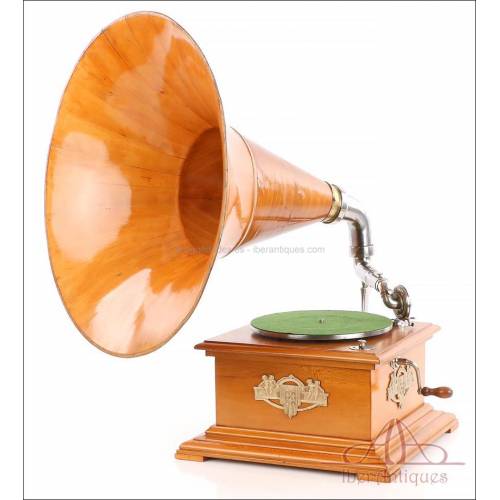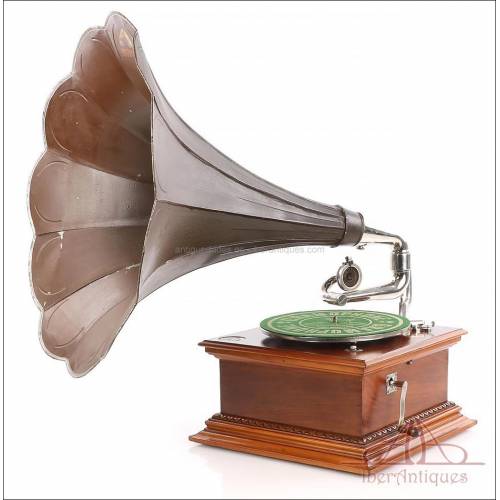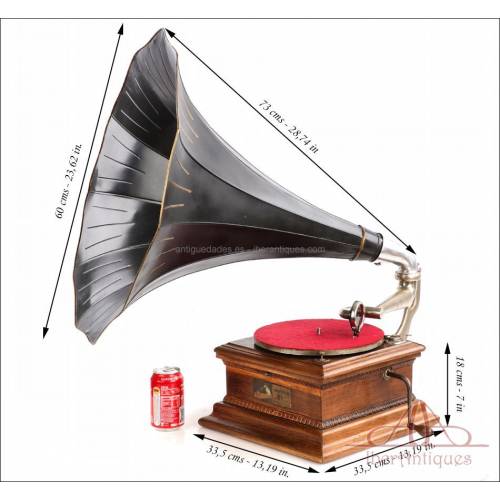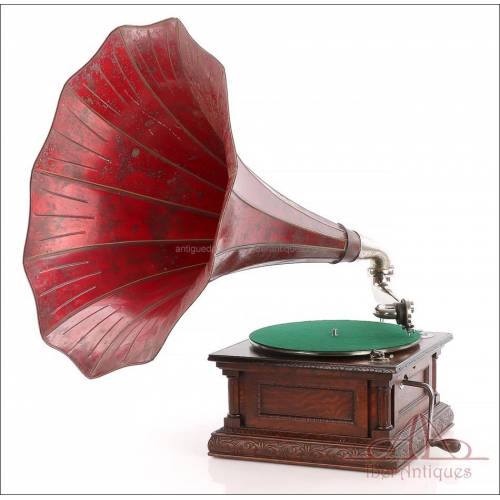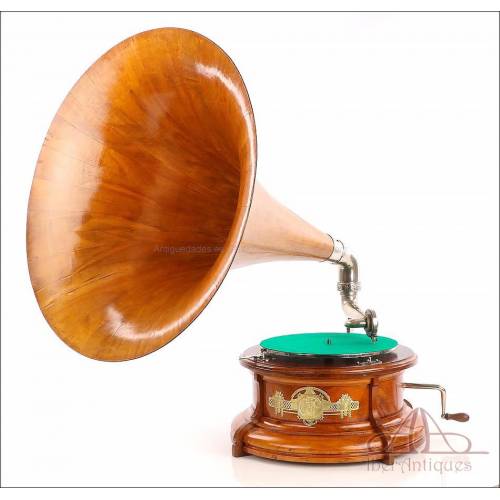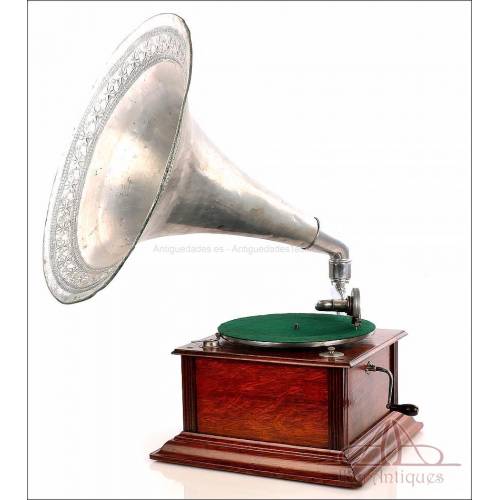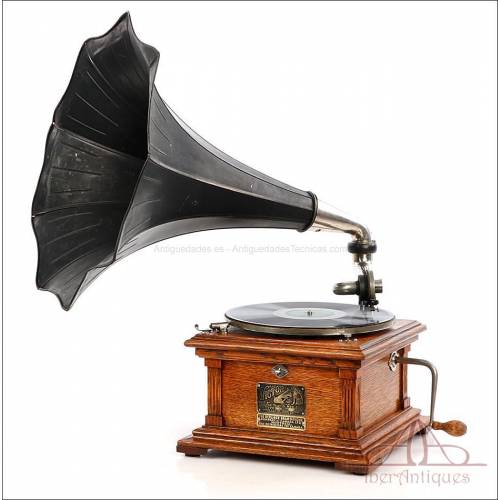Antique Gramophones
Antique jukeboxes are often confused with antique gramophones and identified as such. In reality, jukeboxes are gramophones without an external horn or trumpet. Under this generic name are also included those nostalgic machines that allowed to listen to music in bars, after inserting some coins. Antique gramophones, on the other hand, include all kinds of models: from the magnificent horn or trumpet designs to the practical suitcase or travel gramophones. And not forgetting, of course, the elegant mantel gramophones.
History of antique gramophones
The origin of musical recordings dates back to the first phonographs. Before these devices, an important evolution was assumed: instead of recording sounds on a cylinder, the recording was made on a flat disc. The first was patented in 1887 by Emile Beriner, to whom we also owe the invention of vinyl records. Its design included the classic elements common to all old gramophones: a crank motor (mechanical), a needle with a reproducer, a turntable and a speaker in the form of a horn or trumpet. Although there are dissenting voices on the matter, it is believed that Berliner founded the Victor Talking Machine Company together with Eldridge L. Johnson. This company entered in "commercial war" with Edison and his phonographs, although around 1910 the gramophone definitively displaced the phonograph. From then on and until the arrival of electric record players, its rise and popularity were unstoppable.
Types of antique gramophones
.Trumpet or horn. The first ones that appeared in the market. Their impressive image and good sound has turned them into authentic jewels. To make them work you have to operate the crank; the motor, then, will rotate the plate. Through the reproducer, the sound coming from the contact between the needle and the slate disc reaches the trumpet, which amplifies the sound.
Mantel. Its operation is similar to that of the trumpet gramophones, although in this case the speaker is located under the plate. They do not have a trumpet, which makes them lighter and more functional. They began to be marketed from 1910.
/>Suitcase. Suitcase. Also known as portable, travel or even "picnic" gramophones. They began to be manufactured in 1910 and became very popular. Its parts (reproducer and crank) were guarded disassembled inside a suitcase itself, in whose lower part were the plate and the motor. The loudspeaker, meanwhile, occupied the lid, where there was also usually a compartment to store records.
Marks of antique gramophones. Icons of the nineteenth and twentieth centuries
.Antique gramophones were manufactured and marketed by famous record labels, some of which have survived to the present day (often merged with each other and under other names). The first known record company was the Victor Talking Machine Co. founded in 1901 by Eldridge L. Johnson; in 1930 it was sold to RCA and became known as RCA Victor. Other famous brands of the time were Columbia, Odeon, the French Pathé... However, the best known of all is undoubtedly His Master's Voice (His Master's Voice in the original). At first, this brand and its famous logo with the dog Nipper listening to a gramophone were owned by The Gramophone & Typewriter Company. In 1901 the North American rights became property of the Victor Talking Machine Co.; however, in the Commonwhealt countries it remained property of The Gramophone & Typewriter Co. From 1909, this company became known under the name of the title of the picture, 'His Master's Voice' (HMV).
Antique gramophones are nowadays perfect pieces to decorate any living room with style and personality. Music and vintage antiques lovers will find in our collections the most interesting and sought after models.
Antique Swiss Thorens Gramophone-Phonograph with Mahogany Horn, Switzerland 1910 Antique Swiss Thorens...
Swiss Thorens gramophone-phonograph ca. 1910 with mahogany horn and bronze-adorned case. Restored, motor and reproducer in excellent condition. Swiss Thorens gramophone-phonograph...
SoldAntique His Master's Voice Model 2 Phonograph-Gramophone. Spain, Barcelona, 1910 Antique His Master's Voice Model...
Antique His Master's Voice phonograph-gramophone, model 2, Spain ca. 1910. Restored and in perfect working condition. Antique His Master's Voice...
SoldAntique Oak His Master's Voice Gramophone-Phonograph. France, c. 1910 Antique Oak His Master's Voice...
Beautiful His Master's Voice gramophone-phonograph, original from 1910, with oak case and HMV No. 2 reproducer. Works perfectly and produces a clear, powerful sound. Beautiful His Master's Voice...
SoldAntique G&T (HMV) Monarch Senior Gramophone-Phonograph, France 1910 Antique G&T (HMV) Monarch Senior...
French G&T Monarch Senior gramophone-phonograph ca. 1910. Carved oak case, original horn, triple-spring motor adjusted. Warm and authentic sound. French G&T Monarch Senior...
SoldSwiss Gramophone with Blonde Mahogany Horn, c. 1910, Collectible Piece Swiss Gramophone with Blonde...
Exceptional Swiss gramophone circa 1910, with a hand-carved round case and blonde mahogany horn. Silent motor, warm and powerful sound, a unique piece for collectors. Exceptional Swiss gramophone circa...
SoldAntique Gramophone with Decorated Aluminum Horn, ca. 1915 Antique Gramophone with...
Antique horn gramophone-phonograph from ca. 1915, with decorated aluminum horn and Swiss motor. Restored and functional, it offers excellent sound. Ideal for collectors and retro enthusiasts. Antique horn gramophone-phonograph...
SoldAntique Victor II Type M Gramophone-Phonograph. USA, 1907 Antique Victor II Type M...
Awesome Victor II type M phonograph-gramophone, entirely original. It works and sounds great. Spectacular piece. Awesome Victor II type M...
Sold
New products
-

Antique ivory and silver plated stethoscope, late 19th century
Antique stethoscope from the late 19th century in silver-plated metal...
-

Vintage pendant with shell cameo of Jesús del Gran Poder, carved c. 1970
Vintage pendant with a shell-carved cameo of Jesus del Gran Poder, circa...
-

Antique Roman Style Gilded Silver Chalice with Paten. France, 1932
Antique Roman-style chalice in gilded silver with paten. France, 1932....
-

Beautiful Antique 18 K Gold Ring with 7 Natural Diamonds
Antique 18K gold ring with 7 natural diamonds. Delicate openwork design,...
-

Antique Silver Reliquary. José Vilaplana. Valencia, Spain. Circa 1920
Impressive repoussé silver reliquary by José Vilaplana, Valencia, c....
-

Vintage 18K Gold Ring with 7 Natural Diamonds
Vintage 18K gold ring with seven natural diamonds in floral setting....
-

Antique Silver Chalice. Enameled Crosses. Valencia, Spain, 1942
Spanish chalice from 1942 in solid silver, gifted by the Church of...
-

Antique Silver Chalice and Paten. Granada Spain, circa 1900
Spanish chalice in white silver with matching paten, handcrafted....
Specials
-

Antique Indian Mughal or Khanjar Dagger. Rock Crystal Handle. Damascus, Circa 1900
Wonderful Indian Mughal or Khanjar...

